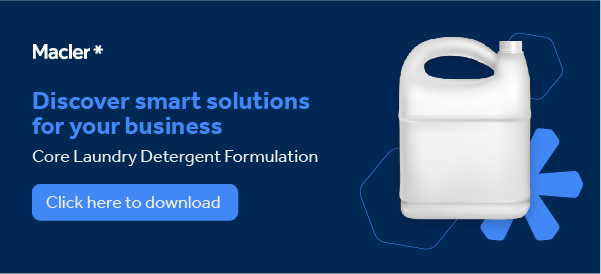
Unravelling laundry formulations

When developing a washing machine, formulators face situations that seem like a dead end. Consumers often look for characteristics that are not always ideal for the product's performance. This is due to cultural factors and movements by digital influencers, who end up inserting some very superficial and limited concepts and analyses into the market, reinforcing beliefs such as the use of bicarbonate, alcohol, and vinegar as magic solutions.
But beyond fads, a solid conceptual basis is essential. This makes it possible to incorporate labelling appeals and specific technical attributes without compromising the efficiency and quality of the product.
To better understand this, read the article on dishwashing detergents first, we explored crucial concepts to any detergent formulation involving foam and viscosity.
Based on these principles, a laundry detergent is nothing more than a variation on the dishwashing theme. The basic composition is similar, but we add inputs to achieve specific technical characteristics for this application.
What are these characteristics?
Moisturising
The product needs to have a good wetting capacity, i.e., it needs to get the clothes deeply wet, penetrating the textile fibres to act on each strand. Good wetting ensures more efficient cleaning, acting in depth and not just on the surface.
Anionic surfactants such as Sulphonic Acid and Sodium Lauryl Ether Sulphate, although not always the best cleaning agents for some types of dirt, especially the heavy ones, are excellent wetting agents for this application, as well as being relatively inexpensive for this function within the formulation.

Foam
Foam is an important cultural factor because, despite being prized by consumers, it does not help with cleaning and can even harm it. During automatic washing, clothes collide, generating friction that increases cleaning capacity. This process can be explained by the Sinner Circle. Click here to find out more.
Foam, however, absorbs shocks, reducing friction and impairing performance. This is why we need to control the foam in a washing machine: it must be present as a signpost for the consumer, but without affecting cleaning. We look for a good volume of foam, but unstable, that comes apart easily so as not to reduce the movement of the garments during washing.
To control the foaming, attention must be paid to the ratio between sulphonic acid and sodium lauryl ether sulphate. The ideal ratio for foam stability is 70% active in Sulphonic Acid and 30% active in Sodium Lauryl Ether Sulphate. For a washing machine, we need to reduce foam stability by increasing the proportion of Sulphonic Acid (for example, 80% active in Sulphonic Acid and 20% in Sodium Lauryl Ether Sulphate).
Even more important is to add a non-ionic surfactant to the formulation. They modify the foam's behaviour, reducing its stability and bringing other cleaning benefits. Nonylphenol 9.5EO is an example, but Macler has removed this surfactant its portfolio because it is extremely harmful to the environment. Click here to find out more.
There are options with better performance, cost-effectiveness, and lower environmental impact, such as Berol 175, a vegetable-sourced surfactant manufactured by Nouryon and distributed by Macler in Brazil.
 Anti-residue
Anti-residue
During the washing process, the dirt removed remains in the eye, in contact with the clothes. As a result, small particles of dirt removed for bathing can re-agglutinate during this process and re-deposit themselves on the fibres. This is why it is important to add anti-redeposition agents to the formulation.
Ethoxylated non-ionic surfactants help prevent re-deposition, both because of their ability to stabilise the emulsion generated during cleaning and because of their ethoxylated part, which acts as a dispersant, preventing the dirt re-agglutinating.
Another effective component is Sodium Polyacrylate, which has great dispersing power. The difference in the cleaning performance of a washing machine with and without this agent is remarkable. However, it is a synthetic product, which can make formulations with more sustainable appeals difficult.
In these cases, biodegradable chelating agents plant sources can be an option, such as Dissolvine GL-47S, manufactured by Nouryon and distributed by Macler in Brazil. As well as protecting anionic actives, fragrances, and colourants against metal ions such as calcium, magnesium, and iron, it acts as a suspending and dispersing agent. Click here to find out more about this solution.
Download the guide to core laundry formulation
As presented in the Dishwasher detergent article, Macler has prepared a guide with dosage indications and product options to be used in formulation development.
With our guide, we hope to help formulators develop efficient and innovative laundry detergents.
Click on the banner below and check it out:

Learn More
While it's true that these compounds have excellent cleaning performance, their acidic or alkaline natures distinguish them in terms of their function during cleaning. In this text, we will focus on addressing caustic products.
Our chemistry
We use our labs to create
intelligent chemical solutions balanced with your reality.
Products
We use our R&D center, our own laboratory with experienced professionals, to deliver intelligent chemical solutions in balance with your reality.
